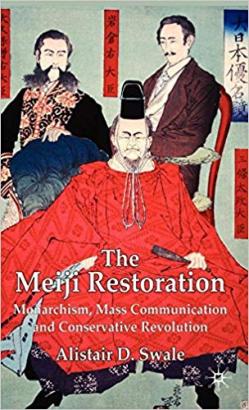The Meiji Restoration, Monarchism, Mass Communication and Conservative Revolution

Review by Sir Hugh Cortazzi
This book by Alistair Swale who is a senior lecturer at the University of Wakato New Zealand is not for the general reader interested in learning about this important period in Japanese history. It seems to have been written for fellow historians already well versed in the history of the Meiji Restoration.
The first chapter deals with ‘Japan within the World system: Urbanization, Political Stasis and Western Economic Expansion’. Swale then considers what he terms as ‘The Meiji Coup d’État’. Subsequent chapters cover ‘Mass Media and the Development of Civil Culture’, “The more thorough fulfilment of the Restoration” and the Imperial Household, the Popular Press and the Contestation of Public Space, The concluding chapter is entitled Conservatism, Traditionalism and Restoration.
Swale asserts that the Meiji Restoration was not so much an ‘instantaneous event’ but more ‘a far-spanning movement that had profound roots in the social conditions and intellectual discourse of the late Edo period’. He asserts that ‘the Imperial Household possessed what the Shogunate did not: the capacity for charismatic inspiration, a religious dimension that would enable incongruent forces and disparate elements to be recast into a new whole as if they had always been destined to be so conjoined.’ He notes that the experiences of the West ‘had a decidedly cautionary impact on many Japanese students’. He stresses that it was not inevitable that the ‘political configuration’ of the new Japan would be liberal or “universalist”. It was ‘perfectly possible to establish a quasi-oligarchical political structure along with an anti-individualist ethos within the compass of the national community.’
As the quotations cited above show this is a densely written book. It is not made easier by the author’s tendency to use long sentences which have to be read more than once before their meaning is apparent. This sentence on page 10 is an example: ‘Maintaining traditions “authentically” requires the retention of the matrix of their production more or less intact, something that is quite impossible when the culture of the village artisan and the relatively self-referencing folklore of the rural community gives way to mass migration of the populace to urban centers which form the focus of development in mass communication and the centralized coordination of a standardized national educational system.’
It is clear from the number of references cited that the author has researched his subject widely, but I was surprised by a number of omissions. For instance when writing about Fukuzawa Yukichi he does not refer to the study of Fukuzawa by the late Dr Carmen Blacker nor to the translation of Fukuzawa’s autobiography by the late Professor Kiyooka. There is no indication that he is aware of the writings of Andrew Cobbing on Japanese students in Britain. Nor is there any mention when discussing the Emperor Meiji of Professor Donald Keenes’ monumental study of the Emperor.

